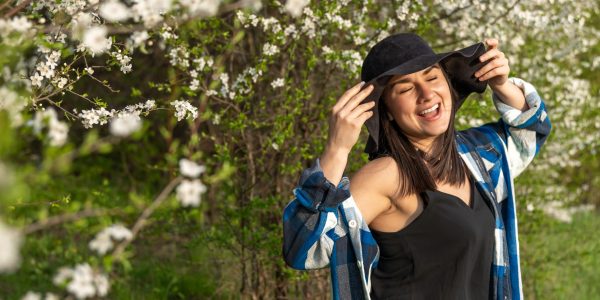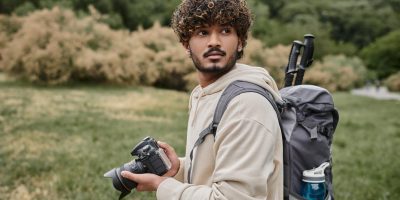Outdoor Portrait Photography: Mastering the Art in the Open

Portrait photography is an intriguing art form, particularly when viewed against the ever-changing background of the great outdoors. For both novices and professionals, street and outdoor portrait photography may bring interesting difficulties in terms of lighting, location, and the spontaneous attractiveness of human subjects. In this detailed book, we’ll dig into the complexities of outdoor portraiture, providing you with a wealth of advice to help you improve your abilities and portfolio. Let’s go on a journey to create interesting photos that will connect with viewers.
The Allure of the Open Shot
What makes outdoor portraits so captivating? It’s the amalgamation of the subject’s story with the surrounding environment. Unlike wedding photography, Outdoor photography may add contextual dimension to the image, turning it into a story rather than just a picture. Each day, the lighting and mood vary, giving an element of unpredictability that may give the shot a distinct impression of timelessness. Mastering the art of outdoor portrait photography involves more than just technical skills; it also demands adaptation to the environment and a good eye for narrative.
Choosing the Right Canvas: Location Matters
The search for the perfect outdoor photograph begins with site exploration. Selecting the right backdrop is critical for showcasing the subject and creating the appropriate atmosphere. Natural light’s subtleties shift throughout the day, which can radically affect the mood of your photographs.
Harnessing the Power of Background
The backdrop of your subjects impacts not only the aesthetic value but the story your image tells. A busy street scene may denote a life in motion, while a serene forest path may imply introspection. Lines, textures, and colors in the background can lead the eye and add layers to the narrative. It is critical to ensure that the background supports the topic without becoming obtrusive. A wide aperture (low f-stop number) results in a shallow depth of field, blurring the background and drawing attention to the subject in sharp relief.
Gear Up: Essentials for the Great Outdoors

Outdoor photography requires specific gear to adapt to various terrains. Moving from a studio to outdoor settings demands reliable and agile equipment.
📸 Camera and Lenses:
- Opt for a full-frame or crop sensor DSLR camera for depth control.
- Consider mirrorless cameras for portability and quality.
- Start with a versatile zoom lens like a 24-70mm for outdoor portraits.
- Prime lenses with wider apertures provide richer subject focus and a pleasing background blur.
🔒 Stability Matters:
- Use a tripod for stability and unique angles.
- In windy conditions, a weighted tripod bag or sandbag can prevent shakes.
- A reflector is handy for adding light to subjects, especially in harsh lighting.
Real-life examples and case studies can showcase how the right gear elevates outdoor photography, capturing stunning moments with precision and creativity.
Striking a Pose: Composition is King

Photography is the art of framing, and when it comes to outdoor photographs, a superb arrangement can elevate an average image to the remarkable. A well-composed image directs the viewer’s attention, gives the eye a break, and offers a balanced tale.
The Rule of Thirds and Variations
Position your subject’s eyes along the top third line of the imaginary Tic Tac Toe grid, created by dividing your frame into nine equal parts. This is the rule of thirds, which provides a pleasing visual organization. Experiment with head positions and negative space to elevate this composition further.
Explore Angles and Perspectives
Don’t be afraid to crouch low or to find vantage points above eye level. Different perspectives can transform the dynamic of your shot. Shooting from below can empower the subject, while shooting down on them can add an element of vulnerability. Curate a visual story by selecting the perspective that best conveys the mood and message.
Looking for a photographer? Call Today!
Dance with Nature: The Elements as Co-Stars
When working outdoors, Mother Nature is an unpredictable partner. Learning to collaborate with her can yield breathtaking results.
Weather as a Mood Setter
The weather serves as a natural filter that can enhance or subvert the intended mood of your photo. Clouds diffuse the light, offering a softer contrast, while rain can add a reflective sheen to surfaces, making colors pop. Understanding basic weather patterns can help you plan your shoot accordingly.
Embracing the Scene’s Natural Elements
Inclement weather can often lead to the most memorable shots. A gust of wind may unfurl a subject’s hair, or a snowfall can provide a natural monochrome frame. Even in calm conditions, the positioning of the sun behind a tree or artificial structures like arches and bridges can serve as framing devices. Adapt to such scenarios by being ready to capture those fleeting moments.
The Art of Enhancing: Post-Processing Techniques

The final stretch of the outdoor portrait journey takes place on your computer or tablet. Post-processing is an opportunity to refine the image, to elevate it beyond the scene it was captured in.
Mastering Color and Tone Enhancement
Software tools like Adobe Lightroom or Adobe Photoshop can help you transform the lighting and color balance of your portraits. Adjust the temperature slider to warm or cool the overall feel of the image. Use the curves tool to add elusive contrast and play with the individual red, green, and blue channels to achieve a more fine-tuned color balance.
Retouching and Editing with Care
Retouching should be unobtrusive and respectful of your subject’s distinctive qualities. Remove any transient flaws or stray hairs that may detract from the spirit of the photograph, but avoid excessive editing, which might result in an unnatural appearance. The idea is to enhance the inherent beauty and character, not to entirely change it.
Next Chapter Media Our Portrait Photographers
The intersection of photography with social media reels has forged new paths, particularly for outdoor portrait photographers. The combination of photography and social media videos has opened up new options, particularly for outdoor portrait photographers. With applications like Instagram, TikTok, and Facebook, there’s never been a better time to show off your outdoor photos.
Next Chapter Media can help you enhance your outdoor photography talents by teaching you how to build a consistent style, engage your audience, and form collaborations. Our experience will provide you with the abilities required to capture the essence of human emotion and connection in your outdoor pictures, transforming them into everlasting works of art. Allow us to assist you on your trip to transform the open space into an endless gallery of exciting moments.

